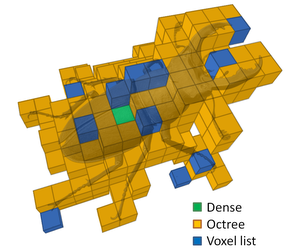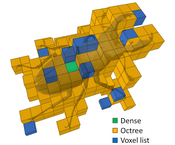Information
- Publication Type: Master Thesis
- Workgroup(s)/Project(s):
- Date: January 2016
- TU Wien Library:
- First Supervisor:
Abstract
Dealing with large, sparse, volume data on the GPU is a necessity in many applications such as volume rendering, processing or simulation. The limited memory budget of modern GPUs restricts users from uploading large volume data-sets entirely. Fortunately, sparse data, i.e., data containing large empty regions, can be represented more efficiently compared to a common dense array. Our approach makes it possible to upload a full data set even if the original volume does not fit on the GPU.In previous work, a variety of sparse data structures have been utilized on the GPU, each with different properties. Tree representations, such as the octree, kd tree or N3 tree, provide a hierarchical solution for data sets of relatively low sparsity. For data sets of medium sparsity, spatial hashing makes more efficient access and storage possible. Extremely sparse data can be efficiently represented and accessed via binary search in sorted voxel lists.
Our observation is, that data sets often contain regions of different sparsity. Depending on the sparsity of a region, a specific data structure (e.g., an octree, a voxel list) requires the least memory to store the data. We formulate an algorithm that is able to automatically find this memory-optimal representation. By using such a combination of different data structures, we achieve an even better representation than any single data structure for real world data sets. We call such a data structure a hybrid data structure.
Any sparse data structure introduces an access overhead. For example, the access to an octree requires one additional indirection per height level of the tree. A voxel list has to be searched to retrieve a specific element. By using a hybrid data structure, we also introduce an access overhead on top of the overhead that comes from using a sparse data structure. In our work we introduce JiTTree, which utilizes a data aware just-in-time compilation step to improve the access performance of our hybrid data structure.
We show that the implementation of our hybrid data structure effectively reduces the memory requirement of sparse data sets. JiTTree can improve the performance of hybrid bricking for certain access patterns such as stencil accesses.
Additional Files and Images
Weblinks
No further information available.BibTeX
@mastersthesis{Labschuetz_Matthias_2016_AHD,
title = "An Adaptive, Hybrid Data Structure for Sparse Volume Data on
the GPU",
author = "Matthias Labsch\"{u}tz",
year = "2016",
abstract = "Dealing with large, sparse, volume data on the GPU is a
necessity in many applications such as volume rendering,
processing or simulation. The limited memory budget of
modern GPUs restricts users from uploading large volume
data-sets entirely. Fortunately, sparse data, i.e., data
containing large empty regions, can be represented more
efficiently compared to a common dense array. Our approach
makes it possible to upload a full data set even if the
original volume does not fit on the GPU. In previous work,
a variety of sparse data structures have been utilized on
the GPU, each with different properties. Tree
representations, such as the octree, kd tree or N3 tree,
provide a hierarchical solution for data sets of relatively
low sparsity. For data sets of medium sparsity, spatial
hashing makes more efficient access and storage possible.
Extremely sparse data can be efficiently represented and
accessed via binary search in sorted voxel lists. Our
observation is, that data sets often contain regions of
different sparsity. Depending on the sparsity of a region, a
specific data structure (e.g., an octree, a voxel list)
requires the least memory to store the data. We formulate an
algorithm that is able to automatically find this
memory-optimal representation. By using such a combination
of different data structures, we achieve an even better
representation than any single data structure for real world
data sets. We call such a data structure a hybrid data
structure. Any sparse data structure introduces an access
overhead. For example, the access to an octree requires one
additional indirection per height level of the tree. A voxel
list has to be searched to retrieve a specific element. By
using a hybrid data structure, we also introduce an access
overhead on top of the overhead that comes from using a
sparse data structure. In our work we introduce JiTTree,
which utilizes a data aware just-in-time compilation step to
improve the access performance of our hybrid data structure.
We show that the implementation of our hybrid data
structure effectively reduces the memory requirement of
sparse data sets. JiTTree can improve the performance of
hybrid bricking for certain access patterns such as stencil
accesses.",
month = jan,
address = "Favoritenstrasse 9-11/E193-02, A-1040 Vienna, Austria",
school = "Institute of Computer Graphics and Algorithms, Vienna
University of Technology ",
URL = "https://www.cg.tuwien.ac.at/research/publications/2016/Labschuetz_Matthias_2016_AHD/",
}

 Poster
Poster Thesis
Thesis


